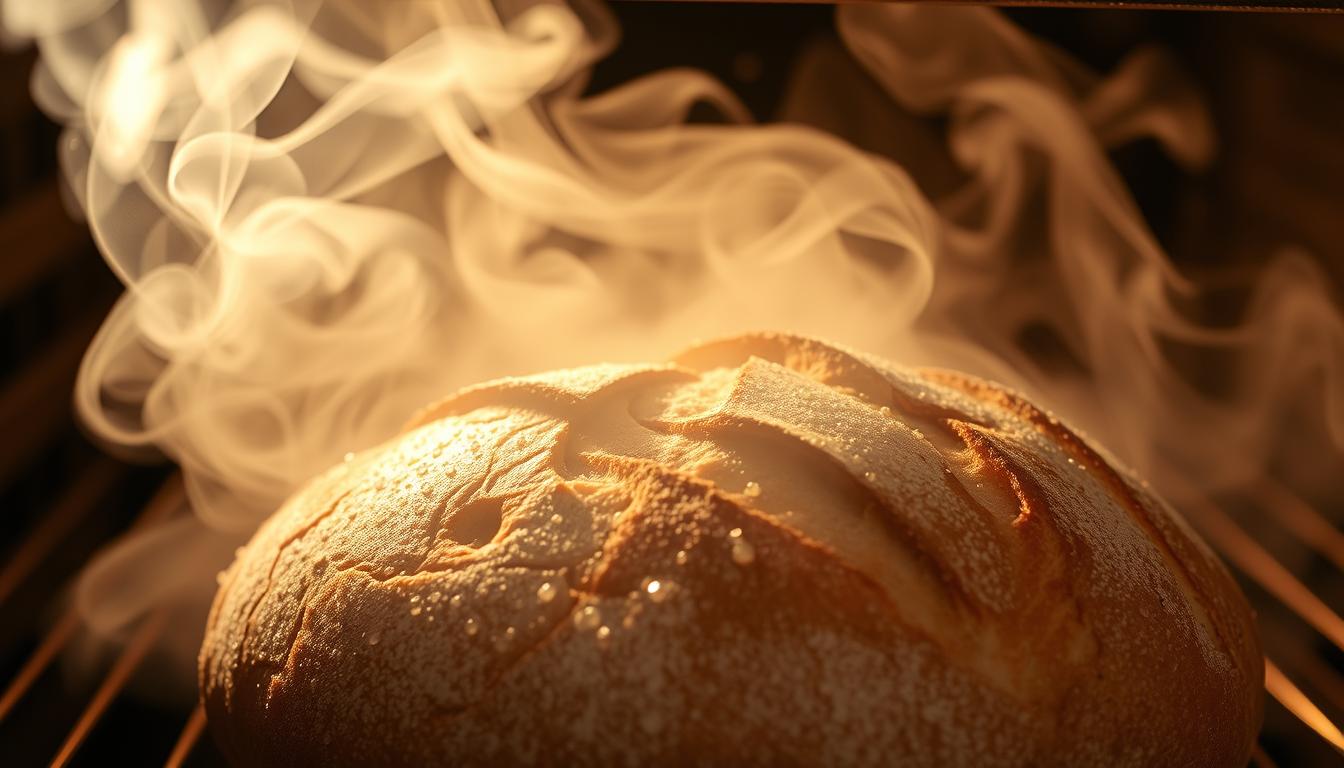Achieving a professional-quality crust and texture is a hallmark of artisan bread baking, and steam plays a crucial role in this process.
The use of steam during the bread baking process contributes to a better oven spring, giving the bread its characteristic rise and texture.
Key Takeaways
- Steam is essential for achieving a professional-quality crust.
- Proper steam application enhances oven spring.
- Sourdough bread benefits significantly from steam during baking.
- Artisan bread baking relies heavily on steam for texture.
- Bread baking with steam results in a more authentic loaf.
The Science Behind Steam in Sourdough Baking
Understanding the science behind steam in sourdough baking reveals its significant impact on dough development and crust formation. Steam is a critical element that influences the baking process, contributing to the characteristic texture and appearance of sourdough bread.
How Steam Affects Dough Development
Steam plays a crucial role in the initial stages of baking. It helps to create a humid environment that allows the dough to expand more freely, promoting a better oven spring. This humid environment delays the formation of the crust, giving the dough more time to rise.
The Role of Steam in Crust Formation
As the baking progresses, steam condenses on the surface of the dough, creating a gel-like layer that eventually becomes the crust. This process contributes to the crust’s color, texture, and flavor. The Maillard reaction, a chemical reaction between amino acids and reducing sugars, is also facilitated by the presence of steam, enhancing the crust’s characteristics.
| Factor | Effect of Steam |
|---|---|
| Dough Development | Promotes oven spring, delays crust formation |
| Crust Formation | Enhances color, texture, and flavor through the Maillard reaction |
| Oven Spring | Facilitates better expansion and rise |
Understanding Oven Spring and Expansion
Oven spring refers to the rapid expansion of dough during the initial baking phase. Steam is essential for maximizing oven spring, as it allows the dough to expand more freely. By controlling the amount of steam, bakers can influence the final texture and appearance of their sourdough bread.
Why Steam is Essential for Professional-Quality Sourdough
Steam is a critical element that can elevate your sourdough bread from good to great, giving it a professional finish. The presence of steam during the initial baking phase significantly impacts the final product’s texture, flavor, and appearance.
The Dramatic Difference Between Steamed vs. Non-Steamed Bread
Bread baked with steam exhibits a noticeable difference in crust texture and appearance compared to bread baked without steam. The steam helps to create a crust that is crispy on the outside and chewy on the inside, a characteristic highly sought after in artisanal breads.
How Steam Contributes to Texture and Flavor
Steam plays a crucial role in developing the texture and flavor of sourdough bread. It allows for a more even expansion of the dough during the initial baking phase, contributing to a better texture. Moreover, steam helps in creating a richer flavor profile by facilitating the Maillard reaction.
The Magic of the Maillard Reaction
The Maillard reaction is a chemical reaction between amino acids and reducing sugars that occurs when food is baked, grilled, or fried, leading to the formation of new flavor compounds and browning. In the context of sourdough baking, steam enhances this reaction, resulting in a more complex flavor and a beautifully browned crust.
Creating That Bakery-Worthy Crust
A bakery-worthy crust is achieved through the combination of steam and precise temperature control. The steam ensures that the crust remains moist during the initial baking phase, allowing for maximum expansion and a more even bake.
Developing Complex Flavors
The Maillard reaction, facilitated by steam, contributes to the development of complex flavors in sourdough bread. This reaction is responsible for the rich, nuanced flavors that are characteristic of professionally baked bread.
Steam Sourdough Baking: Methods for Home Bakers
Steam plays a crucial role in sourdough baking, and home bakers have several methods at their disposal to harness its benefits. By incorporating steam into the baking process, home bakers can achieve a crustier, more artisanal loaf with a tender interior.
The Foolproof Dutch Oven Method
One of the most effective ways to bake sourdough with steam is by using a Dutch oven. This method involves preheating the Dutch oven in the oven, then carefully placing the dough inside and covering it with the lid. The enclosed environment creates a steamy atmosphere that promotes oven spring and crust development.
Cast Iron Pan with Water Technique
Another technique involves using a cast iron pan filled with water. By placing the pan on the bottom rack of the oven and preheating it, you can create a steamy environment. As the water heats up, it releases steam that surrounds the bread, enhancing crust formation.

Using Lava Rocks and Boiling Water
For those without a Dutch oven, using lava rocks and boiling water is a viable alternative. By preheating lava rocks in the oven and then carefully pouring boiling water over them, you can generate a burst of steam. This method requires caution but can be very effective.
Spray Bottle Strategies That Work
A simpler, though slightly less effective, method involves using a spray bottle to create steam. By spraying the oven walls or the bread itself, you can introduce moisture into the baking environment.
When and How to Spray Your Loaf
The timing of when to spray is crucial. Spraying the loaf just before baking or during the initial baking phase can help create a better crust. However, be cautious not to overdo it, as excessive moisture can lead to a soft crust.
Creating a Steamy Environment
To maximize the effect of steam, it’s essential to create a steamy environment from the start. This can be achieved by combining some of the methods mentioned above or by using a combination of preheating and spraying techniques.
| Method | Effectiveness | Equipment Needed |
|---|---|---|
| Dutch Oven | High | Dutch Oven |
| Cast Iron Pan with Water | Medium-High | Cast Iron Pan |
| Lava Rocks and Boiling Water | Medium | Lava Rocks, Boiling Water |
| Spray Bottle | Low-Medium | Spray Bottle |
By experimenting with these methods, home bakers can find the perfect balance of steam to produce a delicious, crusty sourdough loaf.
Timing Your Steam: The First 20 Minutes Are Critical
To achieve a perfectly baked sourdough, understanding the timing of steam application is essential. The first 20 minutes of baking are crucial, as they determine the final texture and crust formation of the bread.
The Initial Baking Phase with Steam
During the initial baking phase, steam helps to create a humid environment that promotes dough expansion and crust formation. This phase is critical for developing the characteristic sourdough bread texture. To achieve this, bakers can use various steaming methods, such as a Dutch oven or a steaming pan.
When to Release Steam for Perfect Results
Releasing steam at the right moment is vital for achieving a perfectly baked crust. Typically, steam is released after 15-20 minutes of baking, allowing the crust to dry and crisp up. The exact timing may vary depending on the specific recipe and oven type.
Finishing the Bake in a Dry Environment
After releasing the steam, the bread is baked in a dry environment to complete the crust formation and achieve the desired browning. This phase is crucial for developing the Maillard reaction, which contributes to the bread’s flavor and color.
How to Tell When Your Bread Is Ready
To determine if the bread is fully baked, look for signs such as a golden-brown crust, a hollow sound when tapped on the bottom, and an internal temperature of around 205°F to 210°F. These indicators will help you achieve a perfectly baked sourdough.
- Check the crust color and texture.
- Tap the bottom of the bread to check for hollowness.
- Verify the internal temperature.
Equipment Considerations for Different Oven Types
Sourdough baking with steam isn’t one-size-fits-all, especially when it comes to various oven types. Different ovens and baking equipment can significantly affect how steam is utilized in the baking process.
Understanding your oven’s characteristics is crucial for adapting steam techniques effectively. Let’s explore how to optimize steam in different oven types.
Working with Electric Ovens
Electric ovens are known for their consistent heat, but they can lack moisture. To create steam, home bakers often use a pan of water or a spray bottle. Preheating the oven with a baking stone inside can also help in achieving a crispy crust.
Gas Oven Steam Strategies
Gas ovens, on the other hand, tend to retain more moisture than electric ovens. This can be advantageous for creating steam. Using a Dutch oven or a combo cooker can enhance steam retention and produce a well-baked loaf.
Baking Stones and Steel: Maximizing Heat
Baking stones and steel are excellent for sourdough baking as they absorb moisture and distribute heat evenly. Preheating these surfaces is essential for achieving a good oven spring.
“The preheated stone or steel acts like a thermal mass, providing a burst of heat to the dough as it starts baking, which is crucial for the initial rise.”
Dutch Ovens and Combo Cookers: Steam Retention Champions
Dutch ovens and combo cookers are designed to trap steam, creating an ideal environment for sourdough baking. They allow for a crispy crust and a well-cooked interior. The key is to preheat them properly and handle them safely.
| Oven Type | Steam Strategy | Recommended Equipment |
|---|---|---|
| Electric Oven | Pan of water or spray bottle | Baking stone or steel |
| Gas Oven | Dutch oven or combo cooker | Dutch oven or combo cooker |
Troubleshooting Common Steam-Related Issues
Steam plays a crucial role in sourdough baking, but it can also be a source of several common problems. Mastering steam management is key to achieving professional-quality sourdough.
Pale or Soft Crust: Not Enough Steam
A pale or soft crust often indicates insufficient steam during the initial baking phase. To address this, ensure that your oven is adequately steamed before baking. Using a Dutch oven or a steamy environment can help.
Limited Oven Spring: Timing Problems
Limited oven spring can be due to incorrect timing of steam release. If steam is released too early or too late, it can affect the bread’s rise. Experiment with different steam release times to find the optimal moment.
Excessive Moisture in Bread: Too Much Steam
Too much steam can lead to a soggy or overly moist crumb. To avoid this, ensure that your oven is not over-steamed and that there’s adequate ventilation. Adjusting the amount of water used for steam or the duration of steaming can help.
Steam Escaping Too Quickly: Sealing Your Oven
If steam escapes too quickly, it may be due to inadequate sealing of the oven. Check your oven’s sealing and consider using a baking stone or steel to retain heat and steam.
Simple Fixes for Common Problems
- Check your oven’s temperature and steam levels.
- Adjust the timing of steam release.
- Ensure proper ventilation to avoid excessive moisture.
- Use baking stones or steels to enhance heat retention.
By addressing these common steam-related issues, bakers can significantly improve the quality of their sourdough bread. Experimentation and attention to detail are key to mastering the art of steam in sourdough baking.
Conclusion: Transforming Your Sourdough with the Power of Steam
By now, it’s clear that steam plays a crucial role in baking professional-quality sourdough bread. The science behind steam’s impact on dough development, crust formation, and oven spring has been explored in detail. As you’ve learned, incorporating steam into your baking routine can dramatically improve the texture, flavor, and overall appearance of your sourdough.
To start transforming your sourdough, experiment with different steaming methods, such as using a Dutch oven or a cast iron pan with water. Timing is critical, so ensure you introduce steam during the initial 20 minutes of baking. By mastering the power of steam, you’ll be well on your way to producing professional-quality bread that rivals that of artisanal bakeries.
As you continue to refine your sourdough baking skills, remember that practice makes perfect. Don’t be discouraged by initial trial and errors – with persistence and patience, you’ll unlock the full potential of steam in transforming your sourdough into a truly exceptional loaf.
FAQ
What is the role of steam in baking sourdough bread?
Steam plays a crucial role in achieving a professional-quality crust and texture. It helps to create a crispy crust, promotes oven spring, and contributes to the development of complex flavors.
How do I create steam in my home oven?
There are several methods to create steam in your home oven, including using a Dutch oven, cast iron pan with water, lava rocks with boiling water, or a spray bottle to spray water onto the bread or oven walls.
Why is the first 20 minutes of baking critical for steam application?
The initial 20 minutes of baking are crucial because steam helps the dough to expand and promotes oven spring. After this period, releasing the steam allows the crust to set and finish baking.
What happens if I don’t use enough steam when baking sourdough?
Without sufficient steam, your sourdough may develop a pale or soft crust and may not achieve the desired oven spring, resulting in a less crispy crust and less complex flavor profile.
Can I use a baking stone or steel with steam?
Yes, baking stones and steel can be used with steam to maximize heat retention and promote a crispy crust. Preheating the stone or steel is essential for achieving the best results.
How do I know when to release steam during the baking process?
The timing for releasing steam depends on the specific baking method and oven type. Generally, releasing steam after the initial 20 minutes of baking allows the crust to set and finish baking.
What are some common issues related to steam in sourdough baking?
Common issues include not enough steam, resulting in a pale or soft crust; too much steam, causing excessive moisture; and steam escaping too quickly, which can be addressed by sealing the oven or adjusting the baking technique.
Can I bake sourdough in an electric oven with steam?
Yes, you can bake sourdough in an electric oven with steam. Using a Dutch oven or a cast iron pan with water are effective methods for creating steam in an electric oven.
How does steam contribute to the Maillard reaction?
Steam helps to facilitate the Maillard reaction by creating a humid environment that promotes the chemical reactions between amino acids and reducing sugars, resulting in the development of complex flavors and a golden-brown crust.





Leave a Reply